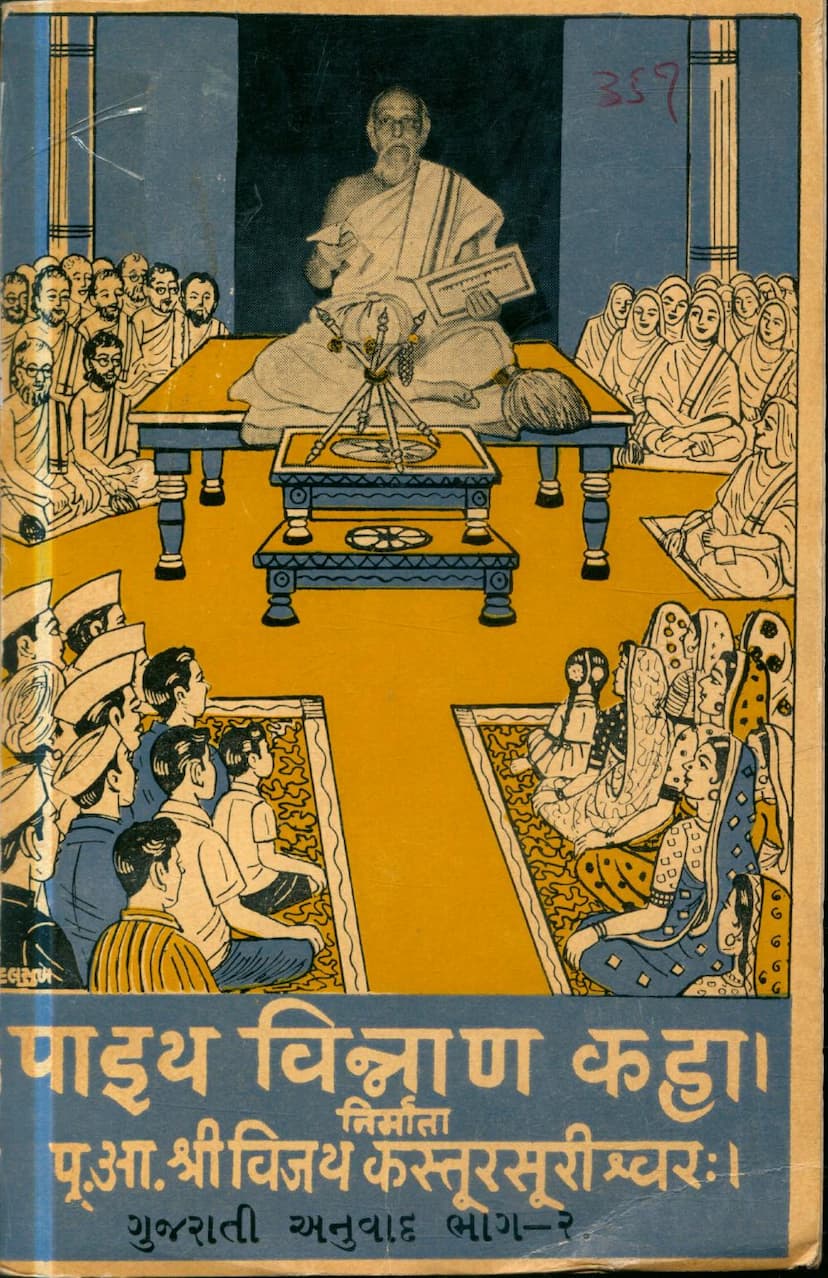Paia Vinnana Kaha Part 02
Added to library: September 2, 2025

Summary
Based on the provided text from "Paia Vinnana Kaha Part 02," here's a comprehensive summary in English:
This volume, "Paia Vinnana Kaha Part 02" (Prakrit Science Stories Part 02), authored by Vijaykastursuri and published by Vijay Nemi Vigyan Kastursuri Gyanmandir, is a Gujarati translation of the second part of a larger work. It contains stories numbered from 56 to 108, totaling 53 narratives.
The book is dedicated to Shri Suryapuramandana Parshvanath and Pujyacharya Dev Shri Vijay-Nemi-Vijnaansurishwar Sadguru Namaha. The introduction highlights the value of storytelling for both relief and moral instruction, emphasizing that these stories, compiled by Acharya Shri Vijaykastursurishwarji Maharaj from various sources and rendered in Prakrit, are not merely for entertainment but are purposeful. Each story concludes with a moral or lesson to be learned.
The publication was made possible through the generous financial contributions and blessings of several individuals and organizations, as listed on page 3. The printing and arrangement were praised, acknowledging the efforts of the printers and compositors.
Key Figures and Their Contributions:
- Pujyacharya Maharaj Shri Vijaykastursurishwarji Maharaj: The primary author of the original Prakrit work.
- Pujyacharya Maharaj Shri Vijay Dharmadhurandharsurishwarji Maharaj: Authored the introductory preface ('Upakram').
- Pujya Acharya Maharaj Shri Vijay Chandroday Surishwarji M.: His teachings guided the financial support for the publication.
- Various Muni Varas: Including Muni Shri Hikarachandravijayji Maharaj (translator), Muni Shri Amarchandravijayji M., Muni Shri Vivekchandravijayji M., and others who assisted with the translation and proofreading.
- Shri Vijay Nemi Vigyan Kastursuri Gyana Mandir: The publisher.
Content Summary of Selected Stories (based on the provided excerpts):
The book contains a collection of moralistic tales, each illustrating a specific virtue or warning against a vice. Here's a brief overview of the stories presented in the excerpts:
-
Story 56: Anand Shravak: Illustrates how a householder can achieve avadhi jnana (clairvoyant knowledge) through purity of intention. Anand Shravak, a devout follower of Lord Mahavir Swami, observes his vows diligently and attains this knowledge. The story also highlights a philosophical debate with Gautam Swami about the nature of truth and perception.
-
Story 57: Nand Maniyar: This tale shows how even right faith (samyakva) can be lost due to association with heretical individuals. Nand Maniyar, after embracing the path of a shravak (lay follower), falls prey to misguided influences, leading to negative consequences. The story emphasizes the importance of righteous company and the dangers of straying from the true path.
-
Story 58: Jungle Under (Jungle Rat): This story emphasizes the immense power of great souls. Lord Dharmanath Jaineshwar is said to have saved a jungle rat from the cycle of rebirth. The narrative details the difficult journey of a queen and her son, their eventual renunciation, and the profound spiritual realization of the humble jungle rat, who is destined to attain liberation first. It also touches upon the concept that right view (samyak dṛṣṭi) prevents one from accumulating negative karma, even when experiencing unfavorable circumstances.
-
Story 59: Bhavini ane Kamrekh: This tale highlights the inescapable nature of karma and destiny. Bhavini, a princess, is predicted to marry Kamrekh, a poor boy. Her attempts to avoid this destiny through ill deeds prove futile, and karma ultimately brings them together, demonstrating the power of fate and the consequences of one's actions.
-
Story 60: Tran Bhaioni: This story, "Three Brothers," emphasizes the superiority of selfless compassion. While the elder brothers focus on outward acts of piety, the youngest brother's act of saving his enemy from drowning, despite personal risk, is shown to be the most virtuous deed, demonstrating the importance of inner virtue over outward show.
-
Story 61: Dhanadatt Sheth: This narrative illustrates the destructive consequences of greed. Dhanadatt Seth's insatiable lust for wealth leads him to commit grave sins, including the murder of his father and others, ultimately resulting in his own demise and a cycle of unfortunate rebirths.
-
Story 62: Brahman Kutumb: This story, "Brahmin Family," shows the misfortune that can befall those afflicted by bad luck and the wisdom of discerning what to ask for. A Brahmin family, despite divine favor, fails to make the right choices due to their misfortune, while a humble blind merchant, through shrewdness and proper prayer, achieves prosperity.
-
Story 63: Samayik upar Vruddha ni Katha: This story, "The Story of the Old Woman on Samayik," contrasts the merits of spiritual practice (samayik) with material charity (dan). It highlights that devoted spiritual practice yields greater spiritual merit than large monetary donations, as exemplified by an old woman's devotion versus a wealthy merchant's material offerings.
-
Story 64: Rajkanya Vishalya: This tale underscores the power of penance and austerity. Princess Vishalya, after facing immense hardships and performing severe penance, not only survives but also attains spiritual liberation, demonstrating the transformative power of dedication to spiritual discipline.
The collection continues with numerous other stories, each carrying a moral lesson, covering themes of karma, destiny, compassion, wisdom, the consequences of greed and anger, the importance of devotion, and the pursuit of spiritual liberation. The book serves as a guide for spiritual and moral upliftment within the Jain tradition.